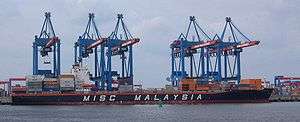Export
An export in international trade is a good or service produced in one country that is sold into another country.[1] The seller of such goods and services is an exporter; the foreign buyer is an importer.[2]
| Part of a series on |
| World trade |
|---|
 |
|
Economic integration
|
Export of goods often requires the involvement of customers authorities. From the buyer's point of view an export is an import.
Firms
Many manufacturing firms begin their global expansion as exporters and only later switch to another mode for serving a foreign market.[3]
Process
Methods of exporting a product, goods or information include mail, hand delivery, air shipping, shipping by vessel, uploading to the Internet, or downloading from a website.
Barriers
Export barriers are divided into four large categories: motivational, informational, operational/resource-based, and knowledge.[4][5]
Trade barriers are government laws, regulations, policy, or practices that protect domestically made products from foreign competition. While restrictive business practices sometimes have a similar effect, they are not usually regarded as trade barriers. The most common foreign trade barriers are government-imposed measures and policies that restrict, prevent, or impede the international exchange of goods and services.[6]
Strategic
International agreements limit trade-in and the transfer of certain types of goods and information, e.g., goods associated with weapons of mass destruction, advanced telecommunications, arms and torture and also some art and archaeological artifacts. For example:
- Nuclear Suppliers Group limits trade in nuclear weapons and associated goods (45 countries participate).
- The Australia Group limits trade in chemical and biological weapons and associated goods (39 countries).
- Missile Technology Control Regime limits trade in the means of delivering weapons of mass destruction (35 countries).
- The Wassenaar Arrangement limits trade in conventional arms and technological developments (40 countries).
Tariffs
A tariff is a tax placed on a specific good or set of goods exported from or imported to a countryside, creating an economic barrier to trade.[7] A tariff may be used when domestic producers are having difficulty competing with imports. Tariffs may also be used to protect an industry that the country views as a matter of its national security.
Some industries receive protection that has a similar effect to subsidies; tariffs reduce the industry's incentives to produce goods quicker, cheaper, and more efficiently, becoming ever less competitive.
The third basis for a tariff involves dumping. When a producer exports at a loss, its competitors may term this dumping. Another case is when the exporter prices a good lower in the export market than in its domestic market.[8] The purpose and expected outcome of a tariff is to encourage spending on domestic goods and services rather than their imported equivalents.
Tariffs can create tension between countries. Examples include the United States steel tariff of 2002, and when China placed a 14% tariff on imported auto parts. Such tariffs usually lead to a complaint with the World Trade Organization (WTO) which sets rules and attempts to resolve trade conflicts.[9] If that is unsatisfactory, the exporting country may choose to put a tariff of its own on imports from the other nation.

Advantages
Exporting avoids the cost of establishing manufacturing operations in the target country.[10]
Exporting may help a company achieve experience curve effects and location economies in their home country.[10] Ownership advantages include the firm's assets, international experience, and the ability to develop either low-cost or differentiated products. The locational advantages of a particular market are a combination of costs, market potential and investment risk. Internationalization advantages are the benefits of retaining a core competence within the company and threading it though the value chain rather than to license, outsource, or sell it.
In relation to the eclectic paradigm, companies with meager ownership advantages do not enter foreign markets. If the company and its products are equipped with ownership advantage and internalization advantage, they enter through low-risk modes such as exporting. Exporting requires significantly less investment than other modes, such as direct investment. Export's lower risk typically reduces the rate of return on sales versus other modes. Exporting allows managers to exercise production control, but does not provide them the option to exercise as much marketing control. An exporter enlists various intermediaries to manage marketing management and marketing activities.
Disadvantages
Exporting may not be viable unless appropriate locations can be found abroad.[3]
High transport costs can make exporting uneconomical, particularly for bulk products.[3]
Another drawback is that trade barriers can make exporting uneconomical and risky.[3]
For small and medium-sized enterprises (SMEs) with fewer than 250 employees, export is generally more difficult than serving the domestic market. The lack of knowledge of trade regulations, cultural differences, different languages and foreign-exchange situations, as well as the strain of resources and staff, complicate the process. Two-thirds of SME exporters pursue only one foreign market.[11]
Motivations
The variety of export motivators can lead to selection bias. Size, knowledge of foreign markets, and unsolicited orders motivate firms to along specific dimensions (research, external, reactive).[4][5]
Macroeconomics
In macroeconomics, net exports (exports minus imports) are a component of gross domestic product, along with domestic consumption, physical investment, and government spending. Foreign demand for a country's exports depends positively on income in foreign countries and negatively on the strength of the producing country's currency (i.e., on how expensive it is for foreign customers to buy the producing country's currency in the foreign exchange market).
See also
- Comparative advantage
- Commodity currency
- Commodity Classification Automated Tracking System
- Demand vacuum
- e-commerce
- Embargo
- Export-oriented industrialization
- Export control
- Export performance
- Export promotion
- Export strategy
- Export subsidy
- Export Yellow Pages
- Free trade
- Free trade agreement
- Free trade area
- Import
- Infant industry argument
- International trade
- List of countries by exports
- Protectionism
- Sales
- Trade barrier
References
- ICC Export/Import Certification
- Joshi, Rakesh Mohan, International Marketing, Oxford University Press, New Delhi and New York. ISBN 0-19-567123-6
- Washington, Charles W. L. Hill, University of (2015). International business : competing in the global marketplace (Tenth edition. ed.). p. 454. ISBN 978-0-07-811277-5.
- Seringhaus, F. R (1990). Government export promotion: A global perspective. Routledge. p. 1. ISBN 0415000645.
- Stouraitis, Vassilios; Boonchoo, Pattana; Mior Harris, Mior Harun; Kyritsis, Markos (2017). "Entrepreneurial perceptions and bias of SME exporting opportunities for manufacturing exporters: A UK study". Journal of Small Business and Enterprise Development. 24 (4): 906–927.
- "Targeted Trade Barriers". cftech.com. Archived from the original on 29 April 2013. Retrieved 27 July 2015.
- Staff, Investopedia (24 November 2003). "Tariff". Investopedia. Archived from the original on 6 December 2017. Retrieved 7 May 2017.
- Mike Moffatt. "The Economic Effect of Tariffs". Archived from the original on 6 September 2015. Retrieved 27 July 2015.
- US/China Trade Tensions Archived 16 May 2011 at the Wayback Machine, Darren Gersh. Retrieved 21 May 2006.
- Hill, Charles W.L. (2015). International Business: competing in the global marketplace (15th ed.). New York: McGraw Hill. p. 454. ISBN 978-0078112775.
- Daniels, J., Radebaugh, L., Sullivan, D. (2007). International Business: environment and operations, 11th edition. Prentice Hall. ISBN 0-13-186942-6